Introduction
In the realm of cloud computing, AWS CloudFormation stands out as a transformative tool that empowers organizations to manage their infrastructure with precision and efficiency. By embracing the principles of Infrastructure as Code (IaC), CloudFormation allows users to define their entire cloud environment through templates, facilitating a seamless orchestration of resources.
As businesses increasingly migrate to the cloud, understanding the core components of CloudFormation—such as stacks, templates, and resources—becomes paramount for effective infrastructure management. Furthermore, the importance of security and best practices cannot be overstated, as they play a critical role in safeguarding deployments against vulnerabilities.
This article delves into the essential aspects of AWS CloudFormation, exploring its benefits, best practices, and advanced techniques that organizations can leverage to optimize their cloud strategies and ensure robust, scalable, and secure infrastructure management.
Understanding AWS CloudFormation: Key Concepts and Components
AWS CloudFormation is a crucial service that simplifies the process of establishing and managing AWS assets by enabling users to define their infrastructure as code (IaC). Understanding its key components is essential for effective infrastructure management and includes:
- Stacks: A stack is a cohesive collection of AWS resources that are managed collectively, allowing for simultaneous creation, update, or deletion.
- Templates: These are structured text files formatted in JSON or YAML that articulate the AWS resources, detailing their properties and dependencies, essential for orchestrating complex environments.
- Resources: These encompass the specific AWS services and components, such as EC2 instances, S3 buckets, and IAM roles, that organizations aim to manage.
As of 2024, security and access management have become essential elements in the implementation of AWS. Effective management practices must be implemented to prevent breaches and misconfigurations, ensuring a secure and reliable infrastructure. In fact, statistics show that robust security measures can significantly reduce the risk of breaches, which is vital for maintaining operational integrity.
Mastering these components not only forms the foundation for successful IaC but also aligns with cloud formation best practices in technology management. As one specialist pointed out, "I highly suggest the second method as it is more developed and establishes natural barriers between the phases in DevOps SDLC," emphasizing the significance of organized procedures in deploying infrastructure configurations. Furthermore, the most prevalent techniques for deploying configuration files are via a GUI or CLI, enabling users to retrieve and handle files efficiently.
This versatility in deployment methods ensures that users can choose the approach that best suits their operational needs.
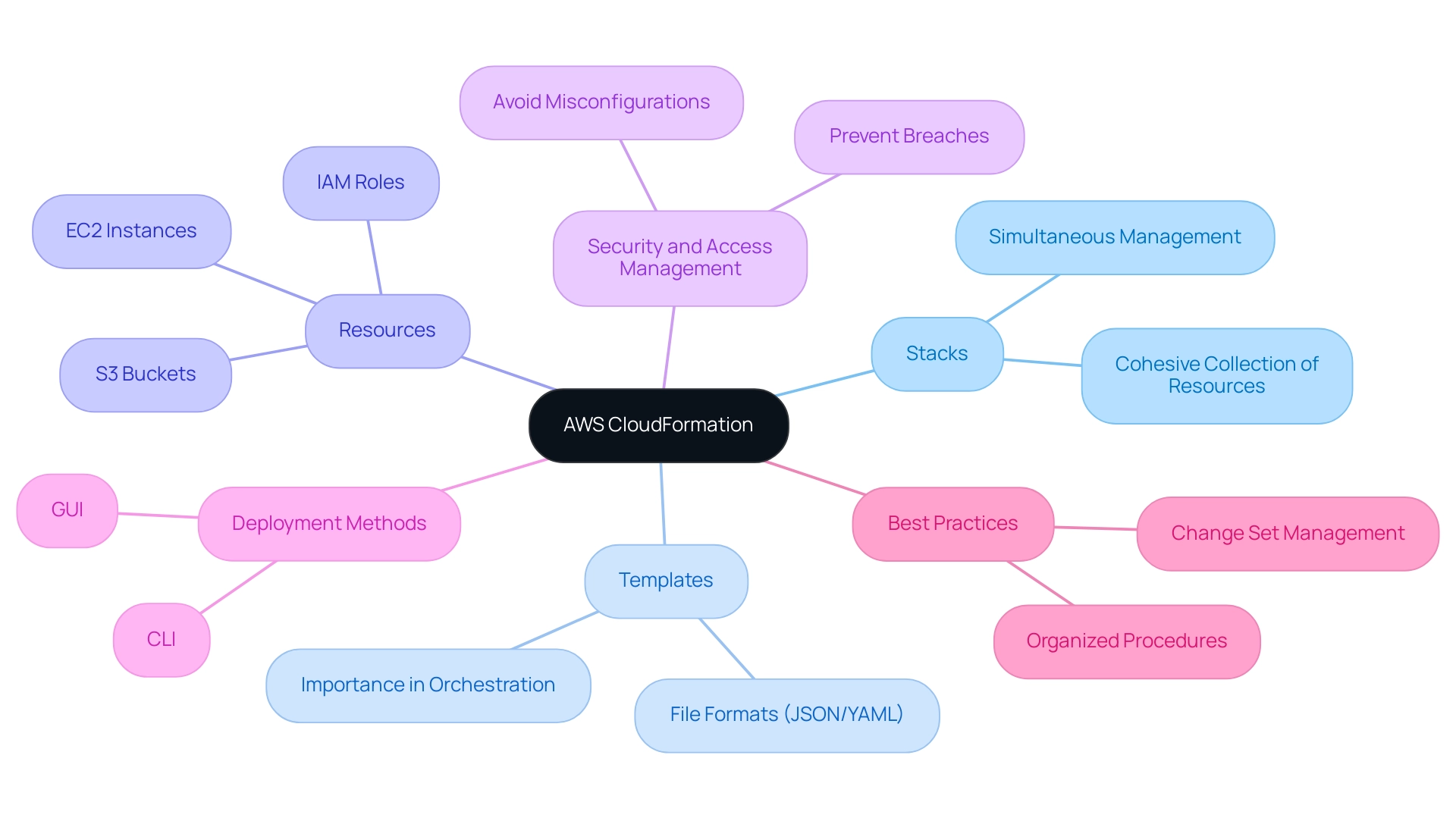
Best Practices for Effective AWS CloudFormation Management
To effectively manage AWS CloudFormation and optimize its capabilities, it is essential to adopt the following best practices:
-
Use Version Control: Implement a version control system, such as Git, for your infrastructure configurations. This practice not only enables tracking changes but also enhances collaboration among team members. The influence of version control on CloudFormation configuration management is significant, especially considering that you can launch only 2000 CloudFormation stacks per Region in your AWS account by default, necessitating careful management of your configurations.
-
Modular Structures: Decompose complex designs into smaller, reusable components, often referred to as nested stacks. This approach enhances maintainability and readability, facilitating easier updates and troubleshooting.
-
Comprehensive Documentation: Ensure that all forms and parameters are clearly documented. This documentation aids team members in understanding the configuration and purpose of each resource, which is crucial for effective collaboration and future modifications.
-
Test Changes in a Non-Production Environment: Always validate your templates in a staging environment before deploying to production. This practice minimizes the risk of downtime and disruptions, aligning with the guidance shared by AWS experts regarding the importance of pre-deployment testing.
-
Monitor Stack Events: Regularly review stack events and logs during the deployment process. Monitoring for errors or warnings allows for timely issue resolution. Utilizing AWS CloudTrail for logging service calls provides a comprehensive audit trail, ensuring accountability and traceability. As noted in a case study, enabling logging and designating an S3 bucket for storage can significantly enhance your auditing capabilities. This practice is especially crucial, as assets altered outside of the infrastructure management tool can result in configuration inconsistencies, making updates more complex.
In summary, incorporating these best practices into your cloud management strategy not only streamlines operations but also safeguards against common pitfalls. As Scott emphasizes, avoiding issues like 'the service cannot update a stack when a custom-named resource requires replacing' is crucial for maintaining a smooth deployment process.
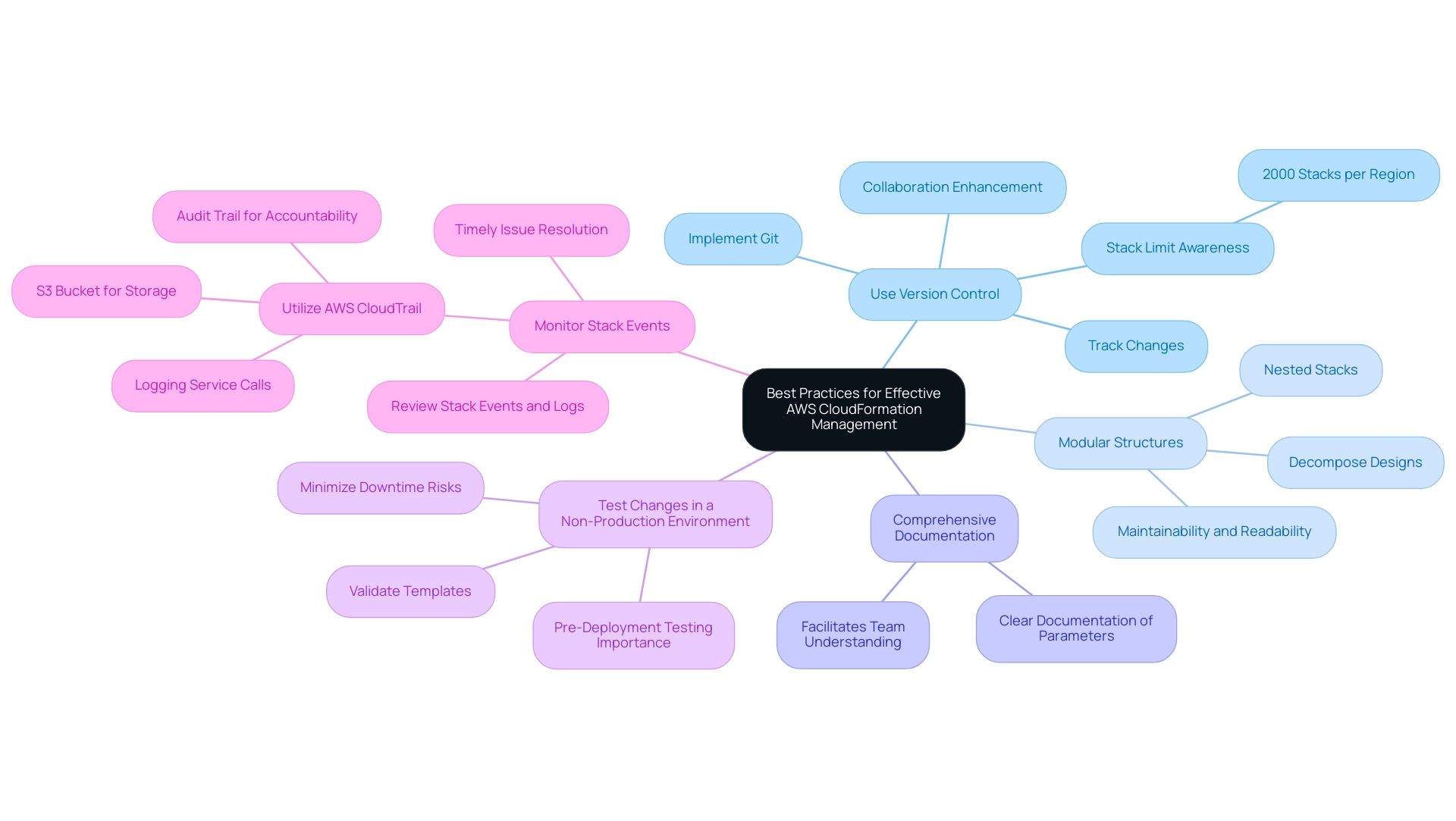
Ensuring Security in AWS CloudFormation Deployments
To enhance the security of AWS deployments, it is essential to adhere to the following best practices:
-
Utilize IAM Roles and Policies: Establishing IAM roles with least privilege access is critical. This approach minimizes exposure by ensuring that users and services interacting with the cloud infrastructure have only the permissions necessary for their tasks. Embedding AWS credentials in mobile applications poses significant security risks; therefore, using IAM roles to delegate access is a safer alternative.
-
Encrypt Sensitive Information: Leverage AWS Key Management Service (KMS) to encrypt sensitive data, such as passwords and API keys, embedded within your templates. This step is vital for safeguarding critical information against unauthorized access.
-
Monitor Changes with AWS CloudTrail: Enable AWS CloudTrail to log all modifications to CloudFormation stacks. This functionality not only provides an audit trail for compliance but also helps in tracking changes and identifying potential security incidents.
-
Conduct Regular Reviews of Security Groups and Permissions: Periodically assess security groups and IAM roles to ensure they comply with best practices. This review process is essential for identifying overly permissive configurations that could expose assets to unnecessary risks, following cloud formation best practices.
-
Implement Stack Policies: Enforcing stack policies can safeguard vital assets from unintended modifications or deletions during stack updates. This precaution ensures that essential components stay secure and functional despite alterations in the deployment environment.
Additionally, consider the statistic that you can only launch 2000 stacks per region in your AWS account. This limitation highlights the significance of managing assets effectively, particularly as your infrastructure scales. A case study by Cycode illustrates the value of integrating security practices within DevOps tools; their approach to security scanning for Infrastructure as Code (IAC) enhances governance and security best practices, ensuring strong authentication and secure development processes are in place.
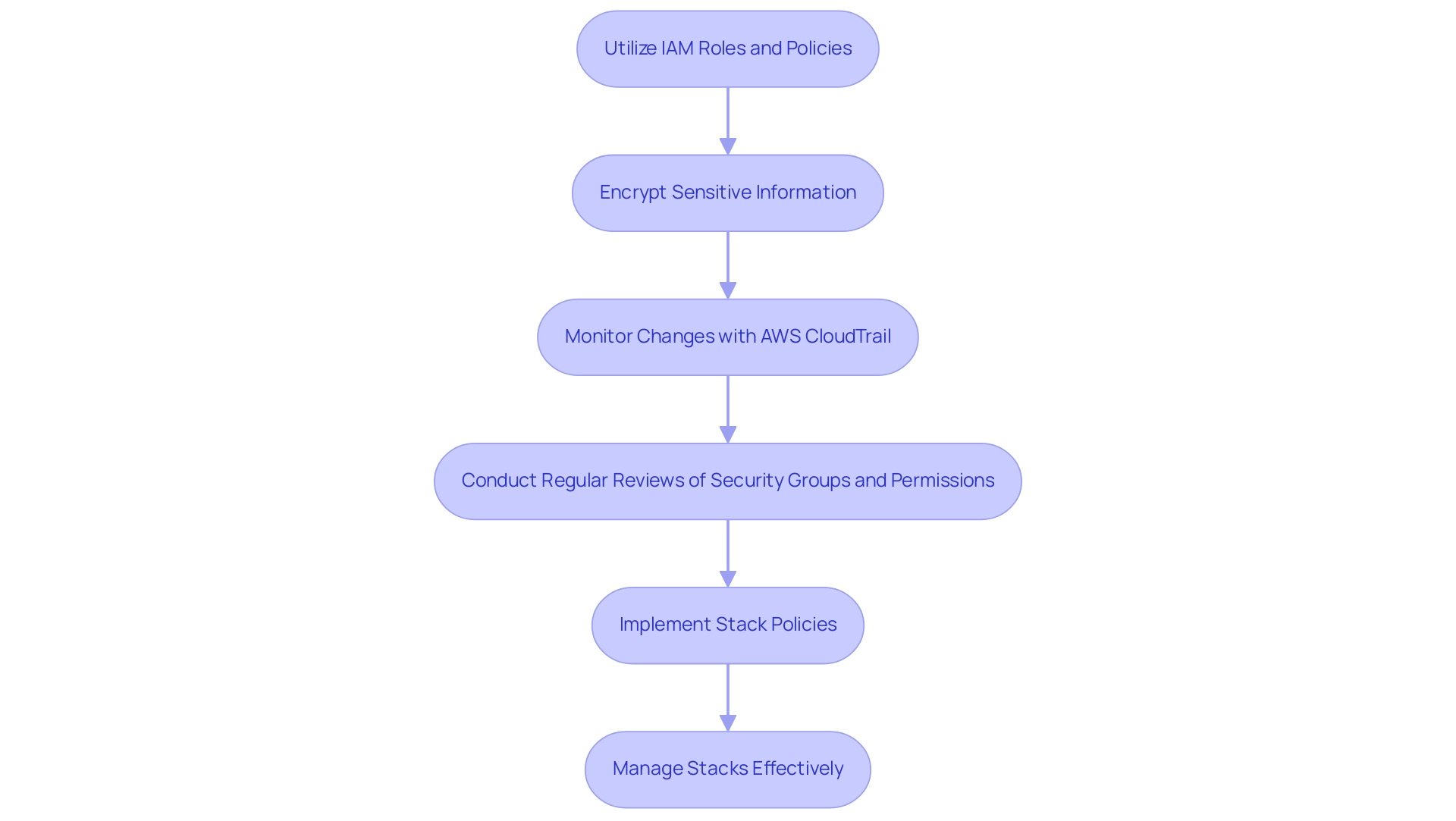
Benefits of Implementing AWS CloudFormation for Infrastructure Management
Implementing AWS services for infrastructure management offers numerous strategic benefits for organizations aiming to enhance their cloud infrastructure management:
- Infrastructure as Code: By embracing Infrastructure as Code (IaC) principles, this solution simplifies the deployment and management of assets. This method allows version management and automated updates, making sure that infrastructure modifications are both traceable and manageable.
- Reduced Deployment Times: Using template configurations greatly speeds up the provisioning of assets, enabling organizations to shift from hours to just minutes for deployment tasks. This improvement in operational agility enables teams to react quickly to business requirements and market shifts.
- Cost Efficiency: AWS automation maximizes utilization through automation, reducing human mistakes and improving overall cost management. By utilizing cloud-native features, organizations can effectively manage expenditures related to provisioning, ultimately resulting in significant cost savings. With over 200 fully-featured services provided by AWS, this tool plays a crucial role in maximizing the benefits of these resources.
- Consistency and Standardization: It ensures uniform environments across development, testing, and production stages by employing consistent templates for resource provisioning. This consistency reduces discrepancies and promotes dependable application performance.
- Easier Rollback: In situations where a deployment faces problems, AWS simplifies the rollback process, allowing teams to revert to a prior stable version of their stack quickly. This capability significantly reduces downtime and service disruptions, ensuring business continuity.
As organizations increasingly embrace cloud technologies and implement cloud formation best practices, AWS empowers enterprises to enhance application modernization, scalability, and agility, making it a critical component of their digital transformation journey. As highlighted in the context of AI & Machine Learning, comprehending the risks linked to Shadow AI and applying efficient cloud management practices can greatly reduce those risks, further underscoring the significance of tools such as AWS. Additionally, the case study on Dependency Management in AWS illustrates how the platform automatically manages dependencies, streamlining stack management and enhancing operational efficiency.
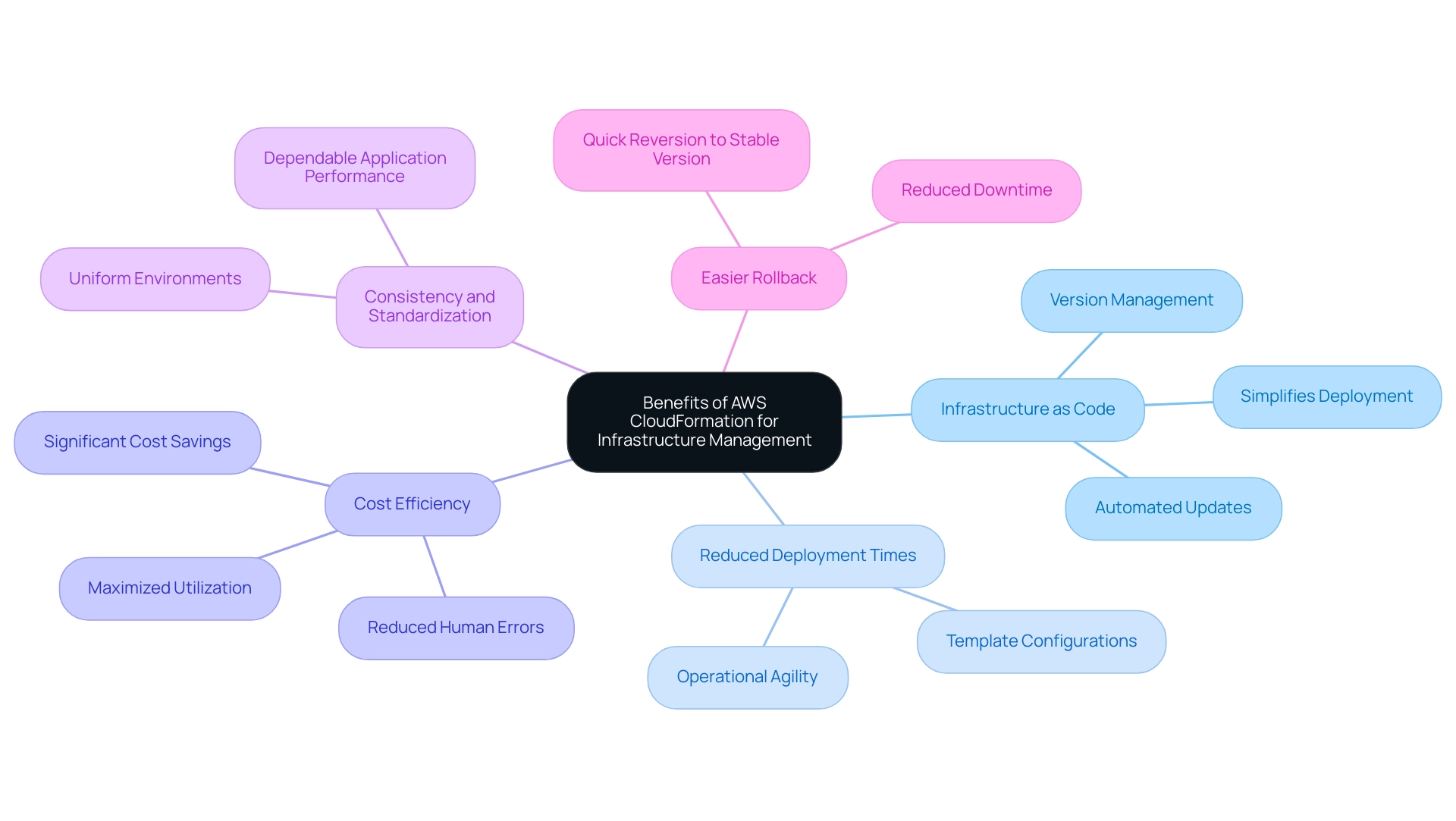
Advanced Techniques for Optimizing AWS CloudFormation Usage
To achieve optimal utilization of AWS CloudFormation, it is essential to adopt several advanced techniques:
-
Integrate with CI/CD Pipelines: Streamline the deployment process of infrastructure stacks by leveraging Continuous Integration and Continuous Deployment (CI/CD) tools such as AWS CodePipeline. This integration enhances efficiency and reduces the risk of errors during deployment.
-
Utilize Custom Resources: Extend the capabilities of the infrastructure as code service by creating custom resources through AWS Lambda functions. This allows for dynamic configurations tailored to specific application needs, enhancing the flexibility of your templates.
-
Leverage Change Sets: Employ change sets to gain insights into how proposed modifications will affect existing stacks. This feature facilitates informed decision-making by previewing the impacts of changes before executing them, thus minimizing potential disruptions.
-
Automate Stack Creation: Utilize automation tools like AWS StackSets to create and manage stacks across multiple accounts and regions. This capability ensures consistency and efficiency in stack management on a larger scale.
-
Monitor Resource Usage: Implement AWS CloudWatch to track the performance metrics of assets provisioned through infrastructure as code. This proactive approach enables ongoing optimization and effective management of resource utilization, ensuring that performance aligns with operational goals.
-
Validate Structures with cfn-lint: Use cfn-lint to validate your CloudFormation structures, ensuring they adhere to best practices and are free of errors before deployment.
-
Test Stacks with TaskCat: Leverage TaskCat for testing your stacks in the chosen AWS Regions. This tool allows you to validate your designs in a real AWS environment, ensuring they function as intended.
-
Case Study: Learning Macros by Example: Developing a macro entails specifying a macro asset that points to an AWS Lambda function for modification. Users can then reference this macro in their templates, illustrating how to invoke macros for template processing effectively.
-
Expert Insight: As Mikelito Luistro observes, 'Tutorials Dojo is a leading and prime tool when it comes to the AWS Certification Practice Tests...' The course I purchased at Tutorials Dojo has been a weapon for me to pass the AWS Certified Solutions Architect - Associate exam and to compete in Cloud World." This highlights the value of comprehensive resources in mastering AWS CloudFormation.
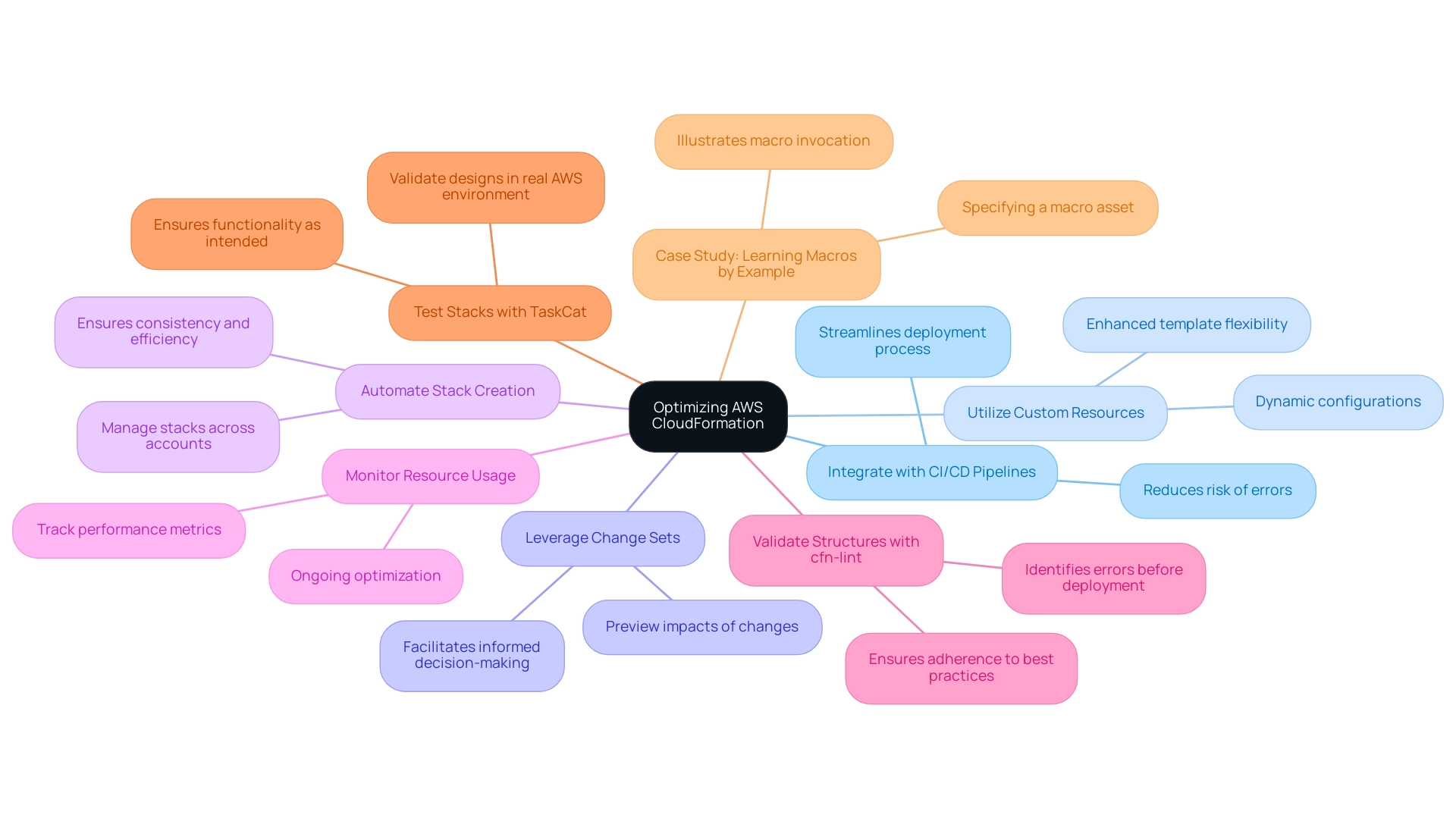
Conclusion
AWS CloudFormation is a powerful solution that transforms the way organizations manage their cloud infrastructure through the principles of Infrastructure as Code. By understanding key concepts such as stacks, templates, and resources, businesses can effectively orchestrate their cloud environments, ensuring streamlined deployment and management processes. The adoption of best practices, from utilizing version control to modularizing templates, not only enhances operational efficiency but also mitigates potential risks associated with misconfigurations and security vulnerabilities.
Security remains a paramount concern, and integrating robust measures such as IAM roles, encryption, and regular audits is essential for safeguarding deployments. Organizations must also prioritize monitoring and reviewing their configurations to maintain compliance and protect against unauthorized access. The benefits of AWS CloudFormation extend beyond security; they encompass reduced deployment times, cost efficiency, and the ability to maintain consistency across various stages of development.
Advanced techniques, including CI/CD integration and the use of custom resources, further optimize the CloudFormation experience, allowing organizations to tailor their infrastructure management to meet specific needs. With ongoing monitoring and validation of templates, teams can ensure that their deployments are not only effective but also resilient to changes and challenges.
In conclusion, embracing AWS CloudFormation is a strategic step for organizations aiming to enhance their cloud infrastructure management. By leveraging its capabilities and adhering to best practices, businesses can achieve a robust, scalable, and secure environment that not only meets current demands but also adapts to future growth and innovation. The journey towards effective cloud management begins with the commitment to understanding and utilizing the powerful tools at one's disposal.




